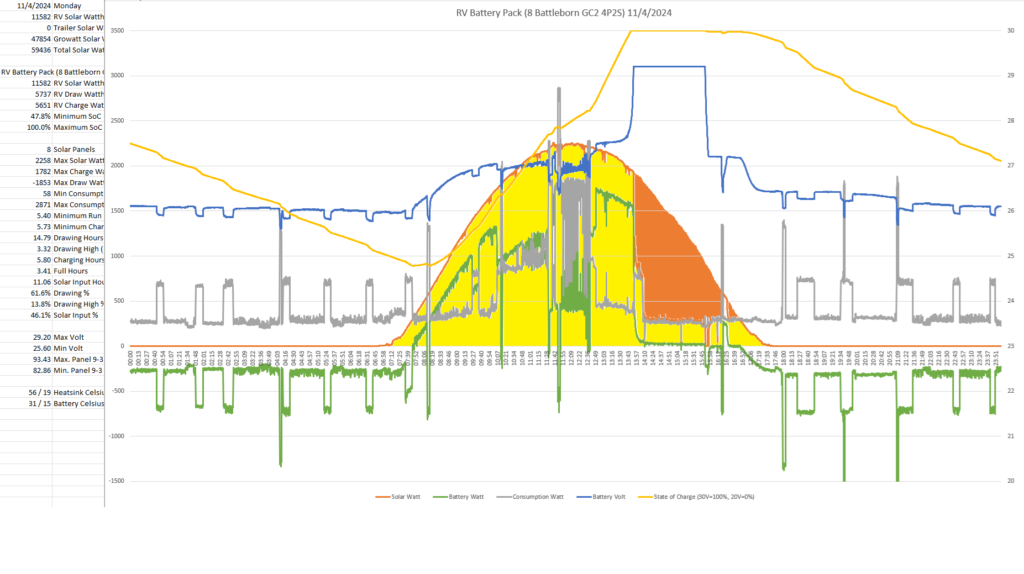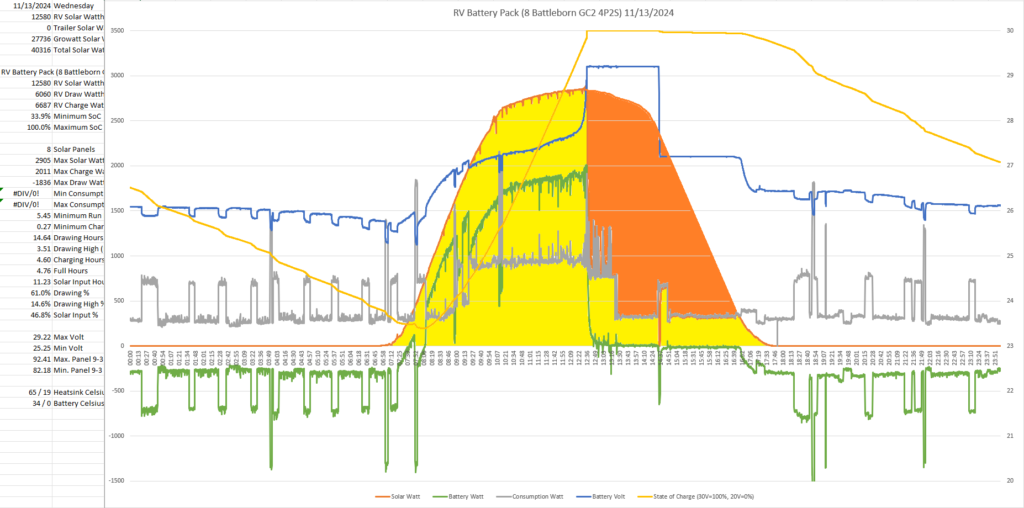Living 100% from solar power is easy in the summer, nights are short and the sun rises higher in the sky. A short night require less time running on batteries and the sun rising higher in the sky makes for a better angle with flat mounted solar panels. Below is 2 graphs with the solar power used (yellow area) versus unused (orange area).
This is the summer scenario from mid-May. The location we was parked in was not optimal for early and late sun, but sunrise was around 5:30 AM and sunset 7:20 PM, making for almost 14 hours of sunlight and only 10 hours of night. The charging finished 12:30 PM leaving plenty of time for extra charging.
The Winter scenario from early November has a perfect curve for solar power. sunrise 7 AM and sunset around 5:30 PM, making only 10.5 hours of daylight and 13.5 hours of night. The charging also finish around 2 PM with only a few hours left in the day.
The longer day in the summer allow for a lot more buffer to charge in case of clouds and the sun high in the sky produce a lot higher maximum output. We have 2 Morningstar 60 Ampere MPPT controllers in our RV and during the summer are they both maxed out mid-day producing up to 3456 Watt (2 * 60 ampere * 28.8 Volt). In the winter is the peak output 2250 Watt or only 65% of the peak power possible. This lower output is all down to the angle of the sun.
The battery storage needed is also higher in the winter. It takes around 1 hour from sunrise to generate enough power to handle the 250 watt "idle" load of our RV. That is 12 hours of night in the summer and 16 hours in the winter. The longer night ends up consuming 30% more of our energy from our batteries. If you also starting cooking dinner at 5 PM is the sun already gone in the winter and it all the energy needs to be taking out of the batteries.
The main thing that really hurt is the potential energy captured from the sun. The lower angle and shorter days make for a lot less buffer, the whole day is required to generate the energy needed. One way to solve this is to angle the solar panels better. but with the 3500 watt of large residential panels is that really not an option, at least not for the solar panels on the roof. But since each controller is is not running at full load can more solar panels be added. We stay the winter in a fixed location most of the time and ground deploy additional solar panels to make of for the reduction.
Solving the low amount of spare energy (orange in above graph) is a problem if using more energy or on a cloudy day. The 8 solar panels on the roof of the RV is now sent to a single 60 Ampere Morningstar controller and the other controller is feed 12 x 250 Watt used solar panels. That almost double the available solar power from 3500 Watt to 6500 Watt. The used solar panels are only $20 a piece and is just placed flat on the dirt (red square on the picture below).
With the extra ground deployed solar panels is the daily buffer reestablished. With 12 kWh produced and still a buffer of ~8 kWh for extra loads or cloudy days. The solar controllers are also maxed out and flat line with two times 60 ampere for hours that is optimal production from our current hardware with the short winter days.
I have found over time that a good rule of thumb to the energy captured from 1000 Watt of flat mounted solar panels is 3 times higher in the summer versus winter. The table below has more details.
We use a 45 degree angle on our ground deployed solar panels and 2500 Watt of solar panels at 45 degree can make up for extra energy needed in the winter to match spring and fall. The extra rows of 30 used 280 Watt panels is used both to increase the RV and trailer energy to cover our need in the winter on cloudy days.





